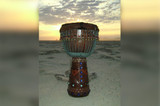Caring for your Didgeridoo
Didgeridoo players are well known as eccentric, creative and talented individuals who have mastered the very difficult concept of circular breathing, can back up any sort of trance or techno beat and are often invited to different workshops, stores or other other events so others can witness the healing abilities of the didgeridoo. Because the didgeridoo is still a curiosity for many, the different people who handle an instrument can go beyond the comfort zone of the didgeridoo player willing to let others try it out. Even if the didgeridoo remains solely in the hands of its owner, there could come a time in which the instrument may need to be cleaned, especially internally. Knowing the right way to care for and maintain a didgeridoo can keep it playing beautifully for years to come.
Synthetic didgeridoos are often constructed from PVC, plastic, fiberglass, and as such, are the easiest type of instrument to clean. Since there is no concern over the effects of waters or oil on the materials used, cleaning a synthetic didgeridoo may only require some soapy water, a small towel or rag, and a smaller pole to push the towel through the instrument. If the didgeridoo is too small for a pole and rag, pouring soapy water into the instrument can suffice as a cleansing solution. For the outside, wiping the surface with a damp cloth can remove any dirt or debris that comes from normal handling. If the didgeridoo has been passed around a drum circle, or just between interested players, pay attention to the mouthpiece in order to remove any residual germs.
Wooden didgeridoos can be made from teak, bamboo, eucalyptus or other hard woods. Depending on the method of crafting, the inside of the didgeridoo can be treated with sealants like varnish or beeswax or left alone, unfinished. For those that are sealed, running a damp towel through the instrument with a smaller pole can wipe away dirt and debris. It is also possible to oil the inside of the didgeridoo with eucalyptus or linseed oil in the same manner, in order to keep the didgeridoo in top condition. Always check with the manufacturer of the didgeridoo for cleaning recommendations, as many instruments are unable to tolerate water or oils, and the process of cleaning or maintaining the didgeridoo can destroy its natural sound quality.
For untreated didgeridoos, it is best to leave the wood alone, and for both methods, a quick rub with a damp cloth on the mouthpiece can suffice for any sanitation needs. Most importantly, however, is keeping any wooden didgeridoo away from extreme temperature and humidity changes. These changes can affect the wood, causing cracks, breaks and an overall sound depreciation.
Caring and maintaining a didgeridoo can keep the instrument in top shape for years to come. By respecting the individual needs of a synthetic or wooden didgeridoo, its ability to play for healing circles, bands or studios can last well into the future, bringing interest, health and joy to the world.
Recent Posts
-
What is the Best Size Djembe for Beginners?
If you're new to the world of percussion and interested in learning the djembe, you're in for a t …16th Jul 2024 -
The Benefits of Becoming a Drumming Teacher: Transforming Passion into Profession
Why become a drumming teacher? Becoming a drumming teacher is an excellent way to share your pas …22nd May 2024 -
What Makes the Djembe Drum a Spiritual Instrument in African Music?
Origin and history of the Djembe drum The Djembe drum originates from West Africa and holds sign …16th May 2024



